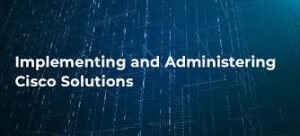CCNA- Implementing and Administering Cisco Solutions
CCNA kurs (200-301): Din vei til Cisco-sertifisering
CCNA , Implementing and Administering Cisco Solutions, gir et omfattende grunnlag for alle som ønsker en karriere innen IT. Dette CCNA kurset kombinerer forelesninger og praktiske øvelser for å lære deg å installere, drifte, konfigurere og verifisere grunnleggende IPv4- og IPv6-nettverk. Gjennom CCNA programmet får du opplæring i å konfigurere nettverkskomponenter som switcher, rutere og trådløse LAN-kontrollere, samt administrasjon av nettverksenheter og identifisering av sikkerhetstrusler.
CCNA kurset går også dypere inn på nettverksprogrammering, automatisering og programvaredefinerte nettverk, noe som gir deg ferdighetene som trengs i moderne IT-miljøer. Dette CCNA kurset er designet for å forberede deg til 200-301 Cisco Certified Network Associate (CCNA)-eksamenen, som er et viktig skritt på veien til en Cisco-sertifisering.
Hvis du søker en fremtid innen nettverk og IT, er CCNA kurset det perfekte valget for å bygge din kompetanse.
NOK 33.000
CCNA COURSE OBJECTIVE:
After completing this CCNA course you should be able to:
• Identify the components of a computer network and describe their basic characteristics
• Understand the model of host-to-host communication
• Describe the features and functions of the Cisco Internetwork Operating System (IOS®) software
• Describe LANs and the role of switches within LANs
• Describe Ethernet as the network access layer of TCP/IP and describe the operation of switches
• Install a switch and perform the initial configurationLes mer
• Describe the TCP/IP Internet layer, IPv4, its addressing scheme, and subnetting
• Describe the TCP/IP Transport layer and Application layer
• Explore functions of routing
• Implement basic configuration on a Cisco router
• Explain host-to-host communications across switches and routers
• Identify and resolve common switched network issues and common problems associated with IPv4 addressing
• Describe IPv6 main features and addresses, and configure and verify basic IPv6 connectivity
• Describe the operation, benefits, and limitations of static routing
• Describe, implement, and verify virtual local area networks (VLANs) and trunks
• Describe the application and configuration of inter-VLAN routing
• Explain the basics of dynamic routing protocols and describe components and terms of Open Shortest Path First (OSPF)
• Explain how Spanning Tree Protocol (STP) and Rapid Spanning Tree Protocol (RSTP) work
• Configure link aggregation using EtherChannel
• Describe the purpose of Layer 3 redundancy protocols
• Describe basic WAN and VPN concepts
• Describe the operation of access control lists (ACLs) and their applications in the network
• Configure Internet access using Dynamic Host Configuration Protocol (DHCP) clients and explain and configure network address translation (NAT) on Cisco routers
• Describe basic quality of service (QoS) concepts
• Describe the concepts of wireless networks, which types of wireless networks can be built, and how to use Wireless LAN Controllers (WLCs)
• Describe network and device architectures and introduce virtualization
• Explain Software-Defined Networks
• Configure basic IOS system monitoring tools
• Describe the management of Cisco devices
• Describe the current security threat landscape
• Describe threat defense technologies
• Implement a basic security configuration of the device management plane
• Implement basic steps to harden network devices
• Discuss the need of network programmability in Enterprise Networks, common programmability protocols, and configuration management tools.
• Introducing AI and ML in Network Operations
TARGET AUDIENCE FOR CCNA COURSE:
Anyone looking to start a career in networking or wishing to achieve the Cisco CCNA Certification.
CCNA COURSE PREREQUISITES:
Attendees should meet the following prerequisites:
• Basic computer literacy
• Basic PC operating system navigation skills
• Basic internet usage skills
• Basic IP address knowledge
CCNA COURSE CONTENT:
Exploring the Functions of Networking
Introducing the Host-To-Host Communications Model
Operating Cisco IOS Software
Introducing LANs
Exploring the TCP/IP Link Layer
Starting a Switch
Introducing the TCP/IP Internet Layer, IPv4 Addressing, and Subnets
Explaining the TCP/IP Transport Layer and Application Layer
Exploring the Functions of Routing
Configuring a Cisco Router
Exploring the Packet Delivery Process
Troubleshooting a Simple Network
Introducing Basic IPv6
Configuring Static Routing
Implementing VLANs and Trunks
Routing Between VLANs
Introducing OSPF
Building Redundant Switched Topologies
Improving Redundant Switched Topologies with EtherChannel
Explaining the Basics of ACL
Enabling Internet Connectivity
Introducing AL and ML in Network Operations
Introducing System Monitoring
Managing Cisco Devices
Securing Administrative Access
Implementing Device Hardening
Exploring Layer 3 Redundancy (Self-Study)
Introducing WAN Technologies (Self-Study)
Introducing QoS (Self-Study)
Explaining Wireless Fundamentals (Self-Study)
Introducing Architectures and Virtualization (Self-Study)
Explaining Software-Defined Networking (Self-Study)
Introducing CCNA Network Programmability (Self-Study)
Examining the CCNA Security Threat Landscape (Self-Study)
Implementing Threat Defense Technologies (Self-Study)
Labs:
• Discovery 1: Get Started with Cisco Command-Line Interface (CLI)
• Discovery 2: Observe How a Switch Operates
• Discovery 3: Perform Basic Switch Configuration
• FAST Lab 1: Implement the Initial Switch Configuration
• Discovery 4: Inspect TCP/IP Applications
• Discovery 5: Configure an Interface on a Cisco Router
• Discovery 6: Configure and Verify Layer 2 Discovery Protocols
• FAST Lab 2: Implement an Initial Router Configuration
• Discovery 7: Configure Default Gateway
• Discovery 8: Explore Packet Forwarding
• Discovery 9: Troubleshoot Switch Media and Port Issues
• Discovery 10: Troubleshoot Port Duplex Issues
• Discovery 11: Configure Basic IPv6 ConnectivityLes mer
• Discovery 12: Configure and Verify IPv4 Static Routes
• Discovery 13: Configure IPv6 Static Routes
• FAST Lab 3: Implement IPv4 Static Routing
• FAST Lab 4: Implement IPv6 Static Routing
• Discovery 14: Configure VLANs and Trunk
• FAST Lab 5: Troubleshoot VLANs and Trunk
• Discovery 15: Configure Inter-VLAN Routing
• FAST Lab 6: Implement Multiple VLANs and Basic Routing Between the VLANs
• Discovery 16: Configure and Verify Single-Area OSPF
• Discovery 17: Configure and Verify EtherChannel
• FAST Lab 7: Improve Redundant Switched Topologies with EtherChannel
• Discovery 18: Configure and Verify IPv4 ACLs
• FAST Lab 8: Implement Numbered and Named IPv4 ACLs
• Discovery 19: Configure a Provider-Assigned IPv4 Address
• Discovery 20: Configure Static NAT
• Discovery 21: Configure Dynamic NAT and Port Address Translation (PAT)
• FAST Lab 9: Implement PAT
• Discovery 22: Configure and Verify NTP
• FAST Lab 10: Configure System Message Logging
• Discovery 23: Create the Cisco IOS Image Backup
• Discovery 24: Upgrade Cisco IOS Image
• Discovery 25: Secure Console and Remote Access
• Discovery 26: Enable and Limit Remote Access Connectivity
• FAST Lab 11: Secure Device Administrative Access
• Discovery 27: Configure and Verify Port Security
• FAST Lab 12: Implement Device Hardening
• Discovery 28: Log into and Monitor the WLC
• Discovery 29: Configure an Open Wireless Network
• Discovery 30: Define a RADIUS Server and Enable SNMP and Syslog
• Discovery 31: Configure a WLAN to Use WPA2 PSK
FOLLOW ON COURSES after CCNA:
This CCNA course covers network fundamentals, network access, IP connectivity, IP Services, security fundamentals and verification of Cisco Networks and is a great starting point for those starting their Cisco career certification journey. The following courses are recommended for further study.
CLFNDU – Understanding Cisco Collaboration Foundations
DCFNDU – Understanding Cisco Data Center Foundations
ENFNDU – Understanding Cisco Enterprise Foundations
SPFNDU – Understanding Cisco Service Provider Network Foundations
WLFNDU – Understanding Cisco Wireless Foundations
Alternatively should you wish to progress to the professional level then you may wish to review
CLCOR – Implementing and Operating Cisco Collaboration Core Technologies
DCCOR – Implementing and Operating Cisco Date Center Core Technologies
ENCOR – Implementing and Operating Cisco Enterprise Network Core Technologies.
SCOR – Implementing and Operating Cisco Security Core Technologies
SPCOR – Implementing and Operating Cisco Service Provider Network Core Technologies

Additional information
| Sted | Virtuelt (90% av våre virtuelle kurs blir tatt opp) |
|---|---|
| Varighet | 5 dag(er) |
| Språk | Engelsk/norsk kursmateriell , englesk/norsk kursholder |

